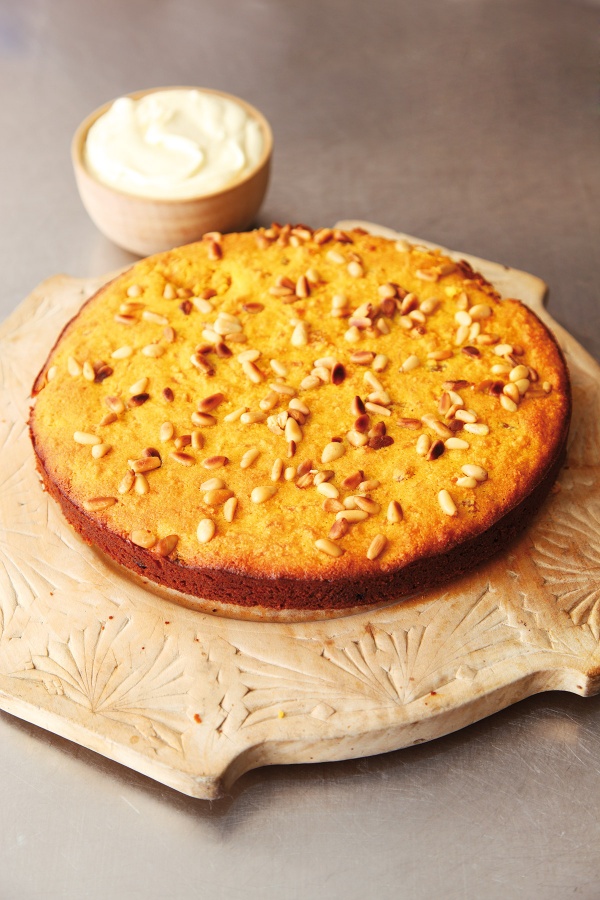Venetian Stew
by Nigella. Featured in NIGELLISSIMAIntroduction
There is an old Venetian dish called, in dialect, Manai, that is the inspiration for this. And I emphasise the word "inspiration": Manai, which broadly speaking involves polenta with beans, bacon and local raisins, is the fruitful starting point for my pink-hued stew, with its beans and bacon and radicchio (my addition, but it does come from Venice), echoing the cinnamon-rose colours of the palazzi that line the Grand Canal.
If you can, buy a good Italian can of borlotti beans as the juice they come in is usable; the gloop in cheaper supermarket own-label brands can be disconcertingly smelly and frankly unfit for consumption. Still, if the only beans you can find need to be rinsed vigorously, you will have to add more water to make sure the beans are covered as they cook. That in turn will make for a runnier stew, so maybe mash some of the beans at the end just to help thicken it.
I adore this salty stew ladled in bowls over a mounded pile of sweet yellow polenta. Or you could consider the Mock Mash, though some unsalty Italian bread with it is enough for me; either way, this is a pretty well instant, soothing and substantial supper.
There is an old Venetian dish called, in dialect, Manai, that is the inspiration for this. And I emphasise the word "inspiration": Manai, which broadly speaking involves polenta with beans, bacon and local raisins, is the fruitful starting point for my pink-hued stew, with its beans and bacon and radicchio (my addition, but it does come from Venice), echoing the cinnamon-rose colours of the palazzi that line the Grand Canal.
If you can, buy a good Italian can of borlotti beans as the juice they come in is usable; the gloop in cheaper supermarket own-label brands can be disconcertingly smelly and frankly unfit for consumption. Still, if the only beans you can find need to be rinsed vigorously, you will have to add more water to make sure the beans are covered as they cook. That in turn will make for a runnier stew, so maybe mash some of the beans at the end just to help thicken it.
I adore this salty stew ladled in bowls over a mounded pile of sweet yellow polenta. Or you could consider the Mock Mash, though some unsalty Italian bread with it is enough for me; either way, this is a pretty well instant, soothing and substantial supper.

Share or save this
Ingredients
Serves: 2
For the stew:
- 25 grams raisins
- 2 teaspoons olive oil
- 150 grams pancetta cubes
- 1 banana shallot (finely chopped)
- 1 clove of garlic (peeled and minced)
- ½ teaspoon ground cumin
- 1 x 400 gram can borlotti beans
- ½ head radicchio (finely shredded)
For the polenta:
- 1 teaspoon Maldon sea salt flakes (or to taste)
- 100 grams instant polenta
- 2 x 15ml tablespoons grated Parmesan
- 1 x 15ml tablespoon unsalted butter
For the stew:
- 3 tablespoons raisins
- 2 teaspoons olive oil
- 6 ounces pancetta cubes
- 1 banana shallot (finely chopped)
- 1 clove of garlic (peeled and minced)
- ½ teaspoon ground cumin
- 1 x 15oz can borlotti beans
- ½ head radicchio (finely shredded)
For the polenta:
- 1 teaspoon kosher salt (or to taste)
- ⅔ cup instant polenta
- 2 tablespoons grated Parmesan
- 1 tablespoon unsalted butter
Method
- Put the raisins into a cup or bowl and pour 125ml/½ cup of boiling water over them.
- Put 675ml/2¾ cups of water in a pan for the polenta and set it on to boil.
- Heat the oil in a heavy-based frying pan of about 28ch diameter (that has a lid) and cook the pancetta (or other) cubes for 3-5 minutes, stirring every now and again, then add the minced garlic and chopped shallott and cook for another 3-5 minutes, until the pancetta is bronzed and the shallot soft.
- Stir in the cumin (not Italian, but Venice was the hub of the spice trade so I allow its inauthentic addition) then add the raisins with their soaking water and let it bubble up before tipping in the borlotti beans and their liquid (but see introduction above if your bean gloop is unusable).
- Bring to the boil, then add the shredded radicchio and, once the stew starts bubbling again, turn off the heat, put on the lid, and get on with the polenta.
- Add salt (to taste) to the now bubbling polenta water, then stir in the polenta, pouring it into the pan in a steady but gentle stream, and cook till smooth and thickened. I use more than the usual ratio of water to polenta here, as I want the finished polenta creamy not set. Once it is cooked, take the pan off the heat and beat in the Parmesan and butter, seasoning to taste. Decant into a warmed serving bowl.
- Check the bean stew seasoning, then bring it to the table with the golden polenta.
- Put the raisins into a cup or bowl and pour 125ml/½ cup of boiling water over them.
- Put 675ml/2¾ cups of water in a pan for the polenta and set it on to boil.
- Heat the oil in a heavy-based frying pan of about 28ch diameter (that has a lid) and cook the pancetta (or other) cubes for 3-5 minutes, stirring every now and again, then add the minced garlic and chopped shallott and cook for another 3-5 minutes, until the pancetta is bronzed and the shallot soft.
- Stir in the cumin (not Italian, but Venice was the hub of the spice trade so I allow its inauthentic addition) then add the raisins with their soaking water and let it bubble up before tipping in the borlotti beans and their liquid (but see introduction above if your bean gloop is unusable).
- Bring to the boil, then add the shredded radicchio and, once the stew starts bubbling again, turn off the heat, put on the lid, and get on with the polenta.
- Add salt (to taste) to the now bubbling polenta water, then stir in the polenta, pouring it into the pan in a steady but gentle stream, and cook till smooth and thickened. I use more than the usual ratio of water to polenta here, as I want the finished polenta creamy not set. Once it is cooked, take the pan off the heat and beat in the Parmesan and butter, seasoning to taste. Decant into a warmed serving bowl.
- Check the bean stew seasoning, then bring it to the table with the golden polenta.
Additional Information
MAKE AHEAD / STORE:
It is not advisable to make ahead. Leftovers should be covered and refrigerated within 2 hours of making, storing stew and polenta separately. Eat within 3 days, reheating stew in a saucepan or microwave until piping hot all of the way through. Polenta can be microwaved until piping hot or sliced and fried in a little olive oil until golden on the outside and hot in the centre.
MAKE AHEAD / STORE:
It is not advisable to make ahead. Leftovers should be covered and refrigerated within 2 hours of making, storing stew and polenta separately. Eat within 3 days, reheating stew in a saucepan or microwave until piping hot all of the way through. Polenta can be microwaved until piping hot or sliced and fried in a little olive oil until golden on the outside and hot in the centre.







Tell us what you think
Thank you {% member.data['first-name'] %}.
Explore more recipesYour comment has been submitted.